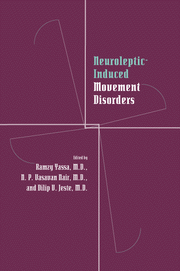Book contents
- Frontmatter
- Contents
- Contributors
- Preface
- Part I Historical perspective
- Part II Clinical aspects of tardive dyskinesia
- 2 Aging and tardive dyskinesia
- 3 Gender as a factor in the development of tardive dyskinesia
- 4 The Yale tardive dyskinesia study: a prospective incidence study among long-term outpatients
- 5 Vulnerability to tardive dyskinesia in schizophrenia: an exploration of individual patient factors
- 6 Tardive dyskinesia and affective disorder
- 7 Diabetes mellitus and tardive dyskinesia
- 8 Other factors in the development of tardive dyskinesia
- 9 Neuroleptic treatment and tardive dyskinesia
- 10 Anticholinergic drugs as factors in the development of tardive dyskinesia
- Part III Mechanisms underlying tardive dyskinesia
- Part IV Measurement of tardive dyskinesia
- Part V Tardive dyskinesia in different populations
- Part VI Other neuroleptic-induced movement disorders
- Part VII Treatment of tardive dyskinesia
- Index
5 - Vulnerability to tardive dyskinesia in schizophrenia: an exploration of individual patient factors
from Part II - Clinical aspects of tardive dyskinesia
Published online by Cambridge University Press: 09 October 2009
- Frontmatter
- Contents
- Contributors
- Preface
- Part I Historical perspective
- Part II Clinical aspects of tardive dyskinesia
- 2 Aging and tardive dyskinesia
- 3 Gender as a factor in the development of tardive dyskinesia
- 4 The Yale tardive dyskinesia study: a prospective incidence study among long-term outpatients
- 5 Vulnerability to tardive dyskinesia in schizophrenia: an exploration of individual patient factors
- 6 Tardive dyskinesia and affective disorder
- 7 Diabetes mellitus and tardive dyskinesia
- 8 Other factors in the development of tardive dyskinesia
- 9 Neuroleptic treatment and tardive dyskinesia
- 10 Anticholinergic drugs as factors in the development of tardive dyskinesia
- Part III Mechanisms underlying tardive dyskinesia
- Part IV Measurement of tardive dyskinesia
- Part V Tardive dyskinesia in different populations
- Part VI Other neuroleptic-induced movement disorders
- Part VII Treatment of tardive dyskinesia
- Index
Summary
After almost 40 years of research, we still do not know why some patients, but not others, develop late-onset involuntary movements – that is, tardive dyskinesia – when they are prescribed neuroleptics on a long-term basis. Although neuroleptics are the primary offending medications in the general sense (but see the conclusion to this chapter), there is little evidence to indicate that patients with tardive dyskinesia may simply have received neuroleptics (or other drugs) for longer periods or at higher dosages than have otherwise similar patients who remain unaffected (Kane & Smith, 1982; Waddington, 1989; Chapter 9, this volume). Much interest centers, therefore, on vulnerability factors within the individual patient.
One of the more consistent findings in research on tardive dyskinesia is a general association with increasing age. It is evident, however, that the syndrome is by no means restricted to the middle-aged or elderly, for it can constitute a substantial clinical problem in younger patients (Kane & Smith, 1982; Waddington, 1989; Chapter 2, this volume), whose fundamental vulnerability apparently resides elsewhere. Similarly, it is often asserted that tardive dyskinesia is more likely to emerge in women than in men, although the evidence to support such an assertion is complex and is far from robust statistically. In fact, among both men and women, an important but often overlooked interaction has emerged between age and severity of the involuntary movements of tardive dyskinesia (Kane & Smith, 1982; Waddington, 1989; Chapter 3, this volume).
- Type
- Chapter
- Information
- Neuroleptic-induced Movement DisordersA Comprehensive Survey, pp. 56 - 68Publisher: Cambridge University PressPrint publication year: 1996



